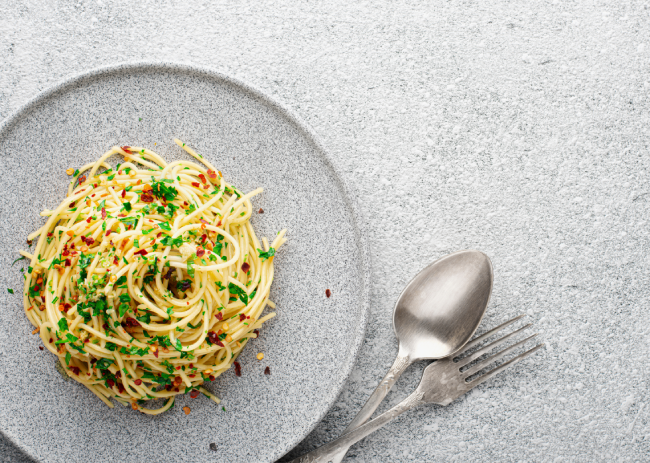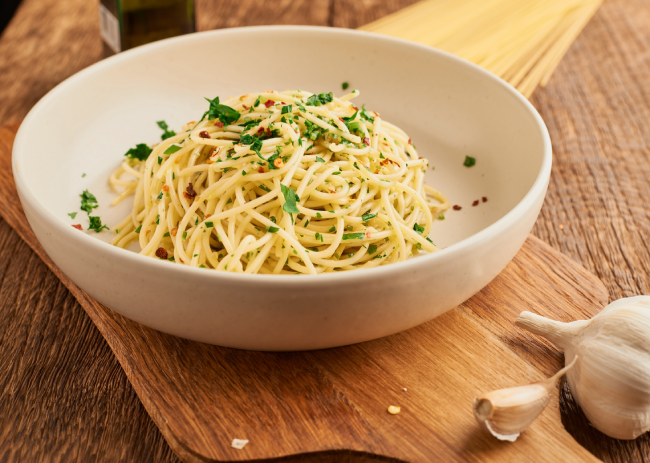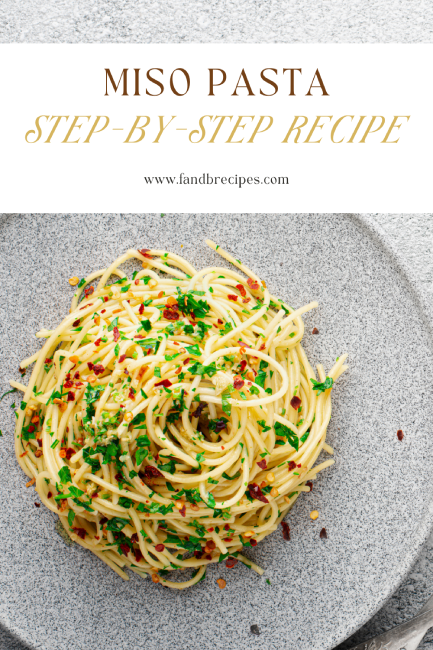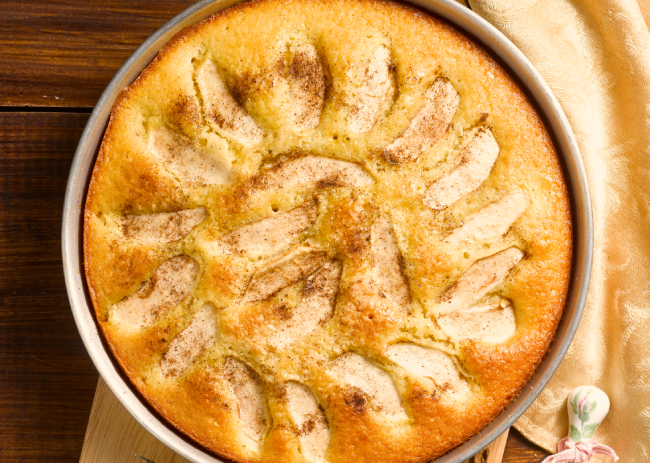Miso Pasta: Step-By-Step Recipe
Miso Pasta is a traditional Japanese ingredient that has been used for centuries to add depth. And also the complexity of flavour to a variety of dishes. Made from fermented soybeans and often combined with other grains, miso paste has a salty, umami flavour. It’s both savoury and satisfying. It’s a staple ingredient in Japanese cuisine. And it is becoming very popular in other parts of the world. Particularly in vegan and vegetarian dishes due to its rich, meaty flavour.
Miso Pasta is versatile and can be used in a variety of ways. You can add it to soups, stews, marinades, dressings, and sauces. It’s done to enhance their flavour and add richness. It can also be used as a spread on toast or mixed into rice or noodle dishes. Miso paste comes in various colours and strengths. It ranges from light and sweet to dark and rich, and each type suits different dishes.
While Miso Pasta is readily available in many grocery stores, making your miso paste at home can be fun. It’s also an excellent way to control the flavour, texture, and quality of the Miso Pasta. And you can experiment with different ingredients to create your unique blend. In this recipe, we’ll show you how to make a basic Miso Pasta using only a few simple ingredients. The process of making Miso Pasta is straightforward but requires patience. Because it can take several months to ferment properly. The result, therefore, is a delicious and nutritious ingredient that you can use in a variety of dishes.
What Is Miso Pasta?
Miso Pasta is a culinary creation that actively combines miso paste, a traditional Japanese fermented soybean product, with pasta. This active integration of flavours results in a dish that actively infuses pasta with the distinct umami flavour of miso. By actively combining the ingredients, Miso Pasta actively fuses elements from both Japanese and Italian cuisines, creating an actively unique and flavourful combination that tantalizes the taste buds.
One of the active benefits of Miso Pasta is the satisfaction it provides to the palate. The active incorporation of miso paste into the pasta sauce actively enhances the overall taste profile, adding depth, richness, and an active umami quality. This active infusion of flavours elevates the pasta dish to a new level of active deliciousness, offering a dynamic alternative to traditional pasta dishes.
Why This Recipe Works
Miso Pasta is a versatile and flavourful ingredient. It is famous in many Japanese dishes, such as miso soup, marinades, and dressings. The recipe for homemade Miso Pasta works. Because it allows you to control the fermentation process. And customize the flavour and texture of the miso to your liking. Making Miso Pasta at home also ensures that you are using high-quality ingredients. And avoiding any unnecessary additives or preservatives.
This recipe uses a combination of soybeans, koji (a type of fungus), and salt to create a rich and savoury Miso Pasta. Soybeans are a great source of protein and are low in fat, making them a healthy addition to your diet. Koji handles the fermentation process. It transforms the soybeans and salt into miso paste. And it also adds a sweet and nutty flavour. The salt not only helps preserve the miso paste. But also enhances the umami flavour and balances the sweetness of the koji.
By following this recipe, you can experiment with many types of soybeans, koji, and salt. It creates a Miso Pasta that suits your taste preferences. The fermentation time can also be adjusted to produce a milder or stronger flavour. In addition, making Miso Pasta at home is a rewarding and satisfying process. It allows you to connect with Japanese culinary traditions and appreciate the art of fermentation.
Ingredients Required to Make Miso Pasta
To make Miso Pasta, you need the following ingredients:
- 12 ounces Pasta: Choose long pasta noodles like spaghetti, linguine or bucatini as they work best for this carbonara-type dish. You can also opt for soba noodles, gluten-free pasta or short pasta if you want.
- 4 tbsp Unsalted Butter: Melt unsalted butter in a pan to add a creamy and rich texture to the dish.
- 3 cloves Garlic: Mince a generous amount of fresh garlic to enhance the flavour. For an extra twist, you can roast the garlic and then add it.
- 4 tbsp Miso Paste: Look for white miso paste at an Asian market or your grocery store. It serves as the main flavour component in the dish. Red or yellow miso can be used as substitutes, but note that they will alter the final flavour.
- 1 ¼ cup Grated Romano Cheese: It is a sheep’s milk cheese known for its salty taste. If you want a milder and buttery flavour, you can use parmesan (freshly grated) as a substitute.
- 1 tsp Pepper and salt: Season with salt and pepper to taste, adding a perfect balance to the dish.
- Furikake: Optionally, sprinkle Furikake (Japanese dried seasoning) made with fish flakes, sesame seeds and seaweed on the pasta. This adds a unique and delightful flavour.
- Green Onions: Garnish with green onions to add freshness and visual appeal to the dish.
By following these steps and using these ingredients, you can create a delicious Miso Pasta that is sure to satisfy your taste buds.
Tools Required to Make Miso Pasta
Here are the tools required to make Miso Pasta:
- Large Pot: To boil water and cook the noodles.
- Strainer: To drain the cooked noodles.
- Mixing Bowl: To prepare the sauce for the Miso Pasta.
- Knife: To chop the vegetables.
- Serving Bowl: To assemble the Miso Pasta dish.
- Large Skillet: Skillet is useful in cooking pasta.
- Measuring Spoons: Measuring spoons are necessary to measure accurate quantities of sauce ingredients.
Miso Pasta Recipe
Miso Pasta brings Italian romano cheese, Japanese miso and lots of garlic in a rich and creamy sauce. Our straightforward recipe ensures you have a gourmet and profound flavour.
Servings: 2 Prep Time: 5 minutes Cook Time: 10 minutes Total Time: 15 minutes Course: Main Course Cuisine: Asian Calories: 575 kcal
Start by putting a large vessel of water to a rolling boil and adding a touch of salt before you begin preparing the delectable miso pasta. Once the water is boiling, add in the pasta. Cook it until it reaches a point just before al dente, ensuring it retains a slight firmness. Remember to reserve around 2 cups of starchy pasta water before draining the pasta and setting it aside momentarily.
Now, take a large skillet and melt the unsalted butter over medium heat. As the butter begins to melt and sizzle, add the minced garlic. Allow it to cook until a tantalizing fragrance fills the air, infusing the dish with its aromatic essence.
With the garlic nicely sautéed, take a whisk and introduce the white miso paste to the skillet. As you whisk, gradually pour in some of the reserved pasta water, ensuring a smooth and creamy consistency is achieved, perfectly blending the miso and the water into a delectable sauce. The miso’s umami flavours will harmonize with the pasta water, resulting in a tantalizingly savoury base.
Without hesitation, gently incorporate the cooked pasta into the skillet, joining forces with the miso sauce. Alongside the pasta, sprinkle in the Romano cheese and a dash of freshly ground black pepper, you can coat the pasta with the luscious sauce. Vigorously toss and stir the pasta, ensuring the cheese melts seamlessly. In addition, ensure that the noodles are fully enveloped in the savoury miso-infused concoction. Should the sauce require additional smoothness, gradually add more of the reserved pasta water to achieve the desired consistency.
Now, it’s time to taste and adjust the flavours to your preference. Sprinkle some salt and pepper if you require, carefully balancing the savoury notes of the miso sauce with the other elements of the dish. Once you’re satisfied with the seasoning, ladle the creamy Miso Pasta into serving bowls, marvelling at the irresistible aroma and tantalizing appearance.
To elevate this delightful creation, generously sprinkle a spoonful of furikake, a Japanese seasoning blend composed of sesame seeds, seaweed, and fish flakes, over the pasta. This will impart an additional layer of complexity and a delightful burst of umami. Finally, garnish the dish with freshly sliced green onions, adding a touch of freshness and a pop of vibrant colour to the presentation.
Now, sit back, savour each bite, and relish in the harmony of flavours as the creamy Miso Pasta delights your taste buds. Allow the comforting warmth and exquisite taste to transport you to culinary bliss.
Tips To Make The Best Miso Pasta
Here are some tips to make the best Miso Pasta:
- Use good quality miso paste: The key to making a flavourful Miso Pasta is using good quality miso paste. Look for miso paste made from fermented soybeans, which has a rich, savoury umami flavour.
- Adjust seasoning to taste: Taste the sauce before mixing it with the noodles. And adjust the seasoning according to your preference. If you like it spicier, add more chilli garlic sauce or if you want it sweeter, add more maple syrup.
- Cook pasta al dente: Cook the pasta until they are al dente, which means they are tender but still have a bit of bite. Overcooked pasta can become mushy and may not hold the sauce as well.
- Don’t overcook vegetables: If you’re adding vegetables to your Miso Pasta, blanch them. Do it to keep their crunchiness and nutrients. Overcooking vegetables can make them soggy and bland.
- Use pasta water to adjust sauce consistency: To thin out the sauce, use some starchy pasta water. Do it to adjust the consistency. This helps to make the sauce more evenly distributed on the noodles.
- Add toppings for extra flavour: Add toppings like thinly sliced cucumber and mushrooms. It can elevate the flavour and texture of the dish. Feel free to experiment with other toppings as well.
Storing & Freezing
Miso Pasta can store in an airtight container in the refrigerator for up to 3-4 days. To reheat, microwave or stir-fry in a pan with a little oil or water. I will not recommend freezing Miso Pasta. Because the texture may change and the flavours may not be as vibrant upon thawing. It is best to make Miso Pasta fresh and enjoy it immediately for the best taste and texture.
FAQs
What Is Miso Paste Made Of?
Miso paste contains fermented soybeans, salt, and koji. It is a type of fungus that breaks down soybeans and adds flavour. Yet, different varieties of miso paste can also include other grains. Such as rice or barley, as well as other ingredients like seaweed or bonito flakes. The exact ingredients can vary depending on the type of miso paste and the region it comes from.
What Does Miso Paste Like?
Miso paste has a salty and savoury taste, known as Umami, with a slightly sweet aftertaste. It also has a distinct aroma, which can vary depending on the type of miso paste and also its fermentation process. Generally, the lighter the colour of the miso paste, the milder its flavour. Light miso paste is sweeter and less salty, while dark miso paste has a stronger flavour and is saltier. The taste of miso paste can enhance the flavours of many different dishes. And it is a versatile ingredient used in a variety of cuisines.
What Does Miso Go Well With?
Miso is a versatile ingredient that you can use in a variety of dishes. It has a savoury, umami flavour. It adds depth and complexity to soups, marinades, dressings, and more. Miso helps in Japanese cuisine. But is popular worldwide due to its unique flavour profile. It has fermented soybeans, rice or barley, salt, and koji, which is a type of fungus. It aids in the fermentation process. The longer the fermentation period, the darker and stronger the miso will be.
Miso pairs well with a wide range of ingredients. It includes seafood, vegetables, meats, and grains. It can help to enhance the flavour of soups and stews, such as miso soup, or as a marinade for grilled fish or tofu. Miso can also help in salad dressings and dipping sauces, adding a savoury and tangy taste. It is a key ingredient in the popular Japanese dish, miso ramen. And can also help as a spread on sandwiches or as a seasoning for roasted vegetables.
What Does Miso Butter Taste Like?
Miso butter is a delicious and versatile condiment that adds a unique flavour to dishes. It has a rich, nutty, and savoury taste that is both salty and sweet. The Umami flavour of the miso paste complements the creamy richness of the butter. It creates a well-balanced and complex taste. Miso butter can also have a slightly tangy and earthy taste depending on the type of miso used. The buttery texture of the mixture makes it easy to spread or melt onto foods. It makes it a good addition to various dishes like roasted vegetables, pasta, and seafood. Miso butter is a delightful condiment that can elevate the flavour of any dish.
What Is Miso Paste In India?
Miso paste is not common in traditional Indian cuisine. Because it is a staple ingredient in Japanese cooking. But, you can find miso paste in stores or gourmet supermarkets in larger cities. With the increasing popularity of Japanese cuisine in India, miso paste is more available. Some chefs and home cooks in India also experiment with miso paste in Indian dishes. Such as lentil soups and curries, for added depth of flavour. While miso paste is not a main ingredient in Indian cuisine, it is gaining recognition. And popularity among food enthusiasts and adventurous cooks in India.
Why Is Miso Not Vegetarian?
Miso paste has fermented soybeans, salt, and sometimes other grains. Such as rice or barley. While miso pastes themselves are plant-based, some miso pastes may contain added ingredients. Such as bonito flakes or other fish-based products to enhance their flavour. This means that not all miso paste is vegetarian or vegan. And it is important to check the label or ingredients list before purchasing miso paste. In addition, some traditional miso recipes may involve the use of animal-derived ingredients. Such as fish or meat to create a broth in which the miso paste is added. Yet, there are also vegetarian and vegan options available. And that do not contain any animal products.
In Conclusion
Miso Pasta is an easy-to-prepare dish that is perfect for those who want to enjoy a flavourful meal. Made with a rich and savoury miso sauce, this dish offers a unique blend of umami flavours. They are sure to please any palate. The mix of creamy peanut butter, tangy rice vinegar, and spicy chilli garlic sauce adds depth to the dish. While fresh vegetables like cucumber and sautéed mushrooms bring a flavour to the dish.
One of the best things about Miso Pasta is how versatile it is. You can adjust the recipe to suit your tastes and preferences. Done by adding your favourite vegetables or protein sources. You can also experiment with different types of noodles. It creates a new and exciting variation of the dish.
Another great thing about Miso Pasta is that it is quick and easy to prepare. With a few simple ingredients and basic cooking tools, you can have a nutritious meal on the table in no time. And because the recipe makes enough for many servings, it’s a great dish to prepare ahead of time.
Finally, Miso Pasta itself is a versatile ingredient that can use in a variety of recipes. Ranging from soups and stews to marinades and dressings. Its unique flavour profile and nutritional benefits. It makes it a popular choice among health-conscious eaters and foodies alike.
If you are looking for a quick and easy weeknight dinner or a flavourful dish to share with friends and family, Choose Miso Pasta. It is a great option that is sure to please anyone. So give it a try and see why this dish has become a favourite among food lovers around the world.

Miso Pasta: Step-By-Step Recipe
Ingredients
- 12 ounces Pasta
- 4 tbsp Unsalted Butter
- 3 cloves Garlic
- 4 tbsp Miso Paste
- 1¼ cup Grated Romano Cheese
- 1 tsp Pepper and salt
To Garnish:
- Furikake
- Green Onions
Instructions
- Start by putting a large vessel of water to a rolling boil and adding a touch of salt before you begin preparing the delectable miso pasta. Once the water is boiling, add in the pasta. Cook it until it reaches a point just before al dente, ensuring it retains a slight firmness. Remember to reserve around 2 cups of starchy pasta water before draining the pasta and setting it aside momentarily.
- Now, take a large skillet and melt the unsalted butter over medium heat. As the butter begins to melt and sizzle, add the minced garlic. Allow it to cook until a tantalizing fragrance fills the air, infusing the dish with its aromatic essence.
- With the garlic nicely sautéed, take a whisk and introduce the white miso paste to the skillet. As you whisk, gradually pour in some of the reserved pasta water, ensuring a smooth and creamy consistency is achieved, perfectly blending the miso and the water into a delectable sauce. The miso's umami flavours will harmonize with the pasta water, resulting in a tantalizingly savoury base.
- Without hesitation, gently incorporate the cooked pasta into the skillet, joining forces with the miso sauce. Alongside the pasta, sprinkle in the Romano cheese and a dash of freshly ground black pepper, you can coat the pasta with the luscious sauce. Vigorously toss and stir the pasta, ensuring the cheese melts seamlessly. In addition, ensure that the noodles are fully enveloped in the savoury miso-infused concoction. Should the sauce require additional smoothness, gradually add more of the reserved pasta water to achieve the desired consistency.
- Now, it's time to taste and adjust the flavours to your preference. Sprinkle some salt and pepper if you require, carefully balancing the savoury notes of the miso sauce with the other elements of the dish. Once you're satisfied with the seasoning, ladle the creamy Miso Pasta into serving bowls, marvelling at the irresistible aroma and tantalizing appearance.
- To elevate this delightful creation, generously sprinkle a spoonful of furikake, a Japanese seasoning blend composed of sesame seeds, seaweed, and fish flakes, over the pasta. This will impart an additional layer of complexity and a delightful burst of umami. Finally, garnish the dish with freshly sliced green onions, adding a touch of freshness and a pop of vibrant colour to the presentation.
- Now, sit back, savour each bite, and relish in the harmony of flavours as the creamy Miso Pasta delights your taste buds. Allow the comforting warmth and exquisite taste to transport you to culinary bliss.
Notes
- Use good quality miso paste: The key to making a flavourful Miso Pasta is using good quality miso paste. Look for miso paste made from fermented soybeans, which has a rich, savoury umami flavour.
- Adjust seasoning to taste: Taste the sauce before mixing it with the noodles. And adjust the seasoning according to your preference. If you like it spicier, add more chilli garlic sauce or if you want it sweeter, add more maple syrup.
- Cook pasta al dente: Cook the pasta until they are al dente, which means they are tender but still have a bit of bite. Overcooked pasta can become mushy and may not hold the sauce as well.
- Don't overcook vegetables: If you're adding vegetables to your Miso Pasta, blanch them. Do it to keep their crunchiness and nutrients. Overcooking vegetables can make them soggy and bland.
- Use pasta water to adjust sauce consistency: To thin out the sauce, use some starchy pasta water. Do it to adjust the consistency. This helps to make the sauce more evenly distributed on the noodles.
- Add toppings for extra flavour: Add toppings like thinly sliced cucumber and mushrooms. It can elevate the flavour and texture of the dish. Feel free to experiment with other toppings as well.





Yummy
I highly recommend this recipe to anyone who enjoys a harmonious blend of ingredients that create a memorable dining experience.